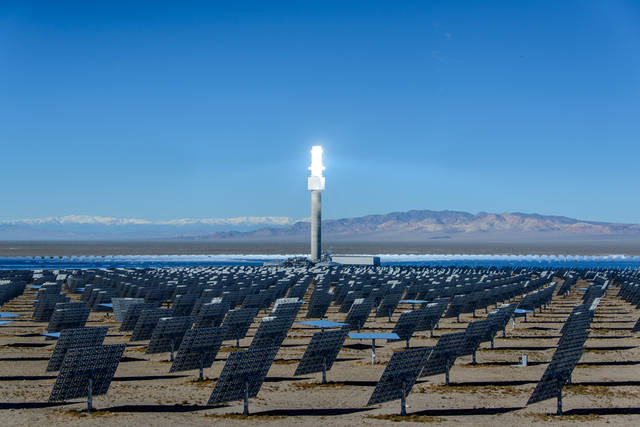EDITORIAL: Future of Crescent Dunes solar plant near Tonopah appears bleak
The vast $1 billion Crescent Dunes solar power plant opened to much fanfare four years ago on federal land northwest of Tonopah. Touted by the developer, SolarReserve, as a first-of-its-kind project that represented the future of clean energy, it featured a patented storage system that supposedly allowed it to deliver power on demand even when the sun didn’t shine.
Now, in another example of how green energy promoters routinely oversell wind and solar as reliable alternatives to fossil fuels, it appears the sun is about to set on Crescent Dunes — and on a $737 million taxpayer handout approved by the Obama administration’s Department of Energy in 2011.
Last week, SolarReserve filed a lawsuit against the Energy Department and the plant’s operator, Tonopah Solar Energy. The legal action centers on a dispute over management of the plant. But the court filing reveals that the operation could be close to bankruptcy because it has repeatedly failed to deliver the power promised and recently lost its only customer, NV Energy.
NV Energy was supposed to receive a steady stream of reliable solar power from the plant through 2040. But last week, the company officially moved to terminate the contract, alleging that the operators failed to meet performance standards. Among other issues, the plant went offline for eight months beginning in late 2016 due to a leak in a molten salt tank.
The developer of Crescent Dunes had also talked up plans for other solar projects throughout the state, including one described as equaling Hoover Dam in power generation. Notably, such proposals appear to have vaporized faster than a nighthawk caught in a solar plant’s concentrated beams of sunlight.
Far from being a “first-of-its-kind” solar project, Crescent Dunes fits the depressingly familiar pattern of many highly touted green energy projects: Proponents lowball the costs and overhype the economic benefits in order to gain political support and federal “loan guarantees.” They then fail to deliver on their promises, leaving taxpayers holding a bad check.
“Americans need to take a critical second look at whether our failed or faltering federal solar initiatives deserve continued support,” David Williams, president of the Taxpayers Protection Alliance, wrote in 2015 for Forbes. “With so little to show for so many costly initiatives, it should be clear to the objective observer that federal solar power efforts haven’t been a productive or prudent use of precious tax dollars.”
That’s not to say there haven’t been rapid advances in the development of solar power resources in recent years. The costs of solar are also coming down. But as the Crescent Dunes project highlights, taxpayers should be wary of green energy promoters selling magic beans as an alternative to traditional energy sources.

















